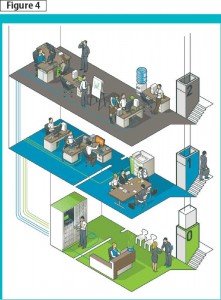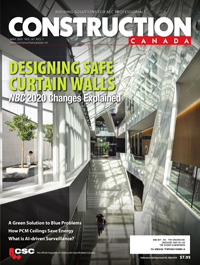Sound Advice: Specifying and procuring sound masking systems

By Niklas Moeller, MBA
Everyone has heard the old adage “silence is golden,” but just as with lighting and temperature, the comfort zone for the volume of sound is actually not zero. In fact, if the background sound level in a space is too low, conversations and noise can easily be heard, even from a great distance, impacting speech privacy and disrupting one’s concentration.
Many organizations use a sound masking system to maintain an appropriate ambient sound level in their facilities, which is typically between 42 and 48 decibels (dB) in commercial interiors. This technology consists of a series of loudspeakers, which are installed in a grid-like pattern in or above the ceiling, and a method of controlling their output. While the sound the loudspeakers distribute has been specifically engineered to increase speech privacy, it also covers up intermittent noises or reduces their impact by decreasing the change between baseline and peak volumes. Although the background sound level is technically higher, occupants perceive the space as quieter. Many systems also provide paging and music distribution, eliminating the need for a separate system.
Sound masking systems have been used in various applications for decades, including:
- offices;
- call centres;
- banks;
- courthouses;
- libraries;
- military facilities; and
- healthcare environments.
In recent years, they have gained even more popularity because of the increased use of open-plan space and demountable partitions, rising densities, and sustainable design practices––all of which have a significant impact on acoustics.
The field has also changed with the introduction of new sound masking systems. Users are no longer limited to a choice between centralized (Figure 1) and decentralized products (Figure 2), but can now select a digital or networked technology (Figure 3). However, what often gets lost in the shuffle are the key design and performance features that can have a substantial impact on the outcome within each space.
The specified slider id does not exist.
The specification gap
Sound masking is a critical design choice for which one does not want to leave a lot of room for interpretation. After all, when purchasing a system, the user is not seeking the mere pleasure of owning the equipment. Without a set of performance standards, poor procurement decisions can be made. The desired level of speech privacy, noise control, and occupant comfort may be sacrificed, as well as the user’s ability to easily and cost-effectively adjust the system in the future.
To keep the focus on design and performance, the manner in which sound masking systems are specified needs to be updated. Currently, they are often specified according to the aforementioned types, limiting the number of vendors that can bid on a given project. Bidding opportunities are further restricted when the specification incorporates propriety elements such as the dimensions of components, types of inputs/outputs, and other minor details. At the other end of this spectrum are specifications that merely state “provide a sound masking system.” When compared to the manner in which most other building systems such as HVAC or fire alarms are specified, the contrast is striking.
The best practice approach for sound masking is to write a performance-based specification focusing on the qualities that are critical to the system’s effectiveness and occupant comfort.
Key performance criteria
A sound masking system’s performance is determined by the following criteria:
- adjustment zone size;
- masking sound generation;
- volume adjustment capabilities;
- frequency adjustment capabilities;
- loudspeaker requirements; and
- measured results.
These six elements are vital to every project’s success. Clear requirements can be set for each one, in addition to various masking technologies that can meet those standards. In other words, a specification focusing on these elements allows competitive bids and, providing the terms of the specification are upheld, also ensures a high performance level from the system selected.

Image © iStockphoto.com/Peter Willems
Adjustment zone size
Acoustic conditions and user needs vary between private offices, meeting rooms, corridors, and reception areas, as well as across open-plan spaces (Figure 4). Sound masking designs with small adjustment zones (i.e. individually controllable groups of loudspeakers) enable the user to adjust the frequency and volume to meet these diverse needs.
Conversely, designs using large adjustment zones––from eight to hundreds of loudspeakers––require the user to make compromises that increase the system’s effectiveness in some areas while diminishing occupant comfort in others, or vice versa (Figure 5, page 2).
The impact of these compromises is far from minimal. A few decibels of variation in masking volume can dramatically impact the system’s effectiveness, even without taking into consideration the consistency of frequency levels. In many situations, users can expect a 10 per cent reduction in performance for each decibel variation below the target masking volume. A poorly designed system can allow as much as a 6-dB variation (i.e. ±3 dB), meaning the system’s effectiveness will be halved in some areas of the user’s space.
Zone size also affects the ease with which the user can make changes to the system in the future. Churn rates and renovations require systems that can be quickly, easily, and cost-effectively readjusted. Large zones limit the user’s ability to reconfigure the sound masking system without first physically changing its design, moving loudspeakers, or re-wiring parts of the system.
In other words, the most important factor within a sound masking specification is to place an upper limit on adjustment zone size. In this case, less truly is more––one to four loudspeakers in each zone provide a high degree of flexibility.







